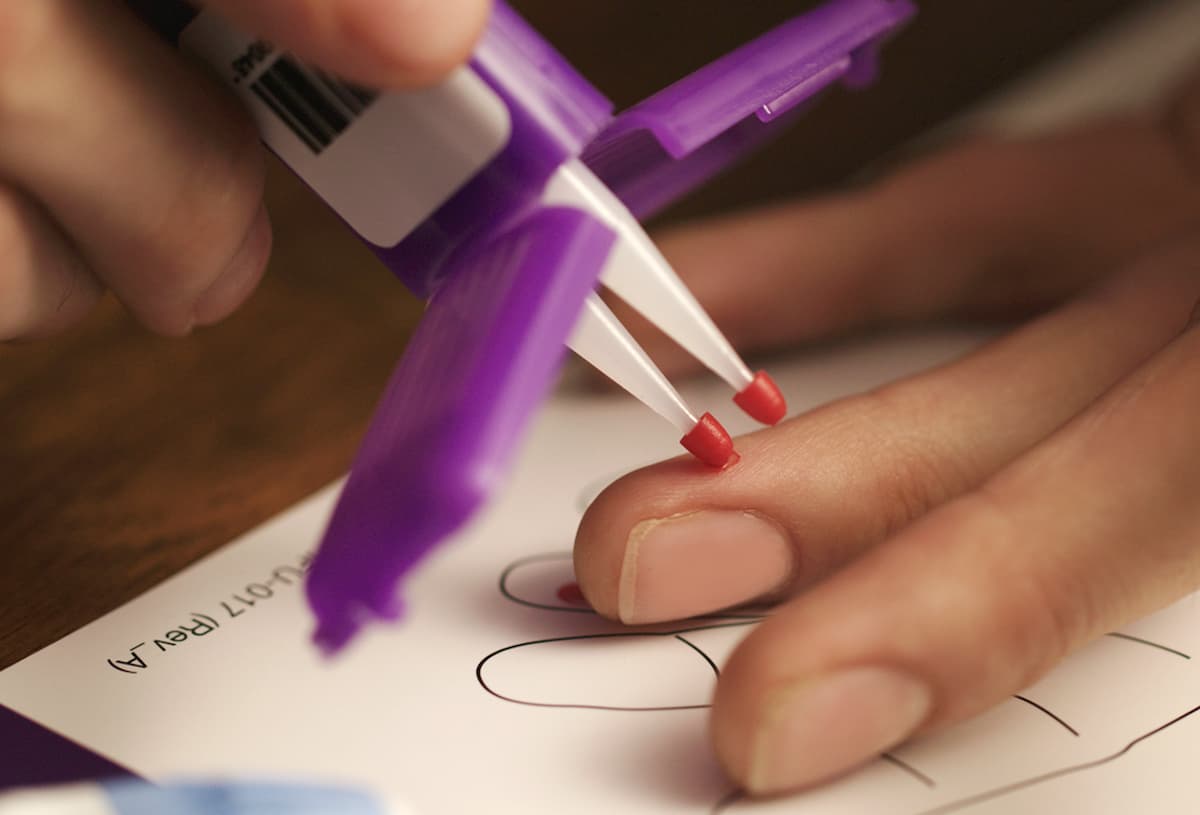Share this
hydroxychloroquine to treat COVID-19: at-home specimen collection examined
by Neoteryx Microsampling on Apr 13, 2020 10:00:00 AM
At the beginning of April 2020, it was reported by Johns Hopkins University that the number of COVID-19 infections had surpassed the 1 million mark globally, and the number of cases was still rising. In the face of the devastating novel coronavirus that causes COVID-19 infections, the race is on to find effective treatments as well as an effective vaccine.

Treatments being investigated include a trial in New York, where plasma enriched in antibodies from recently recovered patients was given to newly infected patients, in an attempt to assist their immune systems in making their own antibodies. Other potential treatments include repurposing antiviral drugs and others designed to help inhibit the immune system from overreacting to foreign invaders, including viruses. This overreactive response is called a cytokine storm, which in some patients can cause sepsis that results in organ failure, or even death.
Investigating Hydroxychloroquine as a Possible Treatment for COVID-19
Of all the potential treatments that have been highlighted in the popular press, the prophylactic antimalarial drugs Chloroquine (CQ) and Hydroxychloroquine (HCQ) are creating the most buzz. According to a review from The Centre for Evidence-Based Medicine (CEBM) at Oxford University (UK) on the current clinical evidence, there appears to be a growing and encouraging dataset that indicates these drugs may help. However, the CEBM review emphasizes that the firm science around the efficacy that these antimalarials have on treating COVID-19 is not yet confirmed. More research is needed before scientists recommend the wide-spread use of CQ and HCQ as a COVID-19 therapy.
Hydroxychloroquine: Proposed Modes of Action
There appears to be a number of potential modes of action against the SARS-CoV-2 virus to treat those suffering with COVID-19. According to the CEMB review, one mode of action is that CQ and HCQ could inhibit viral cell binding by reducing glycosylation of angiotensin converting enzyme 2. Another mode is inhibition of proinflammatory cytokines, which would prevent the aforementioned cytokine storms. Researchers report that CQ also appears to accumulate in lysosomes, which could prevent the virus from causing endosome rupture, thus reducing cellular viral spread.
At-Home Specimen Collection: A Safer Way to Prove Efficacy of COVID-19 Treatments
As COVID-19 cases continue to multiply at a worrying rate, the need to conduct rapid but safe clinical trials is paramount. One way to achieve this is by running virtual clinical trials in which remote specimen collection options are provided to people. They can use at-home collection kits to self-collect specimens. People can then send their samples back in the regular mail. The samples collected with at-home kits from Neoteryx utilize volumetric absorptive microsampling (VAMS) technology, which enables precise and validated analysis.
At-home collection kits from Neoteryx are currently being used to conduct COVID-19 studies, and new studies are launching every day. In fact, the National Institutes of Health (NIH) announced the use of Mitra® microsamplers from Neoteryx for a large study of COVID-19 immunity. NIH researchers are confident in using these remote microsamplers because, for a number of years, Mitra microsampling has been used in worldwide clinical trials. Last year for example, UCB Biopharmaceuticals announced at the EUMED conference that they implement the Neoteryx remote microsamplers in their worldwide drug trials.
Established Use of Mitra Devices with VAMS in a Hydroxychloroquine Bridging Study for RA
In 2017, a clinical bridging study was conducted on HCQ and its metabolites by researchers focused on improving Rheumatoid Arthritis (RA) care in the US. It has been observed that CQ and HCQ, are not only effective against malaria, they are also effective against autoimmune diseases and are used as a treatment for Lupus and RA. Unfortunately, it has been reported that medical adherence of HCQ is quite poor. Indeed, out of 750,000 patients taking HCQ it has been estimated (2016) that only 50% of patients have beneficial circulating levels of the drug. Therefore, it was proposed that regular therapeutic drug monitoring of HCQ could improve adherence levels and improve outcomes.
The 2017 paper, published by Ying Qu et al, reported on how they conducted a bridging study. Fifty-four HCQ patients from a wide demographic participated in the study. The results were very promising, and the study authors report that the Deming regression analysis indicated that the concentrations of HCQ and its metabolites in remote microsamples correlated exactly with those found in venous blood. They also reported that the HCQ and its metabolites were stable at ambient temperature for up to 10 days on the Mitra microsamplers. Moreover, the samples were shown to be stable at 50 °C when incubated for 24 hours.
Conclusions
Qu and co-investigators concluded that the Mitra devices with VAMS tips could be used to remotely collect bio-fluids for Therapeutic Drug Monitoring (TDM), and concentrations of HCQ. Their conclusions mirror many examples in the literature reporting similar results using Mitra devices. These examples show that using Mitra with VAMS technology for remote microsampling is a practical option for a broad range of studies. Therefore, an at-home specimen collection option that is self-managed by remote study participants is a promising alternative for those looking to embark on virtual clinical trials exploring COVID-19 therapies during the Coronavirus Pandemic and beyond.
Topics: Viral Pathogens, Remote Patient Monitoring, COVID-19
Sources
https://www.niaid.nih.gov/news-events/nih-begins-study-quantify-undetected-cases-coronavirus-infection
https://www.bbc.co.uk/news/world-52144390
https://www.eufemed.eu/wp-content/uploads/3.5-Chanteux-with-video-1.pdf
https://www.sciencedirect.com/science/article/abs/pii/S0731708517301528

Share this
- Microsampling (206)
- Research, Remote Research (119)
- Venipuncture Alternative (105)
- Clinical Trials, Clinical Research (83)
- Mitra® Device (73)
- Therapeutic Drug Monitoring, TDM (51)
- Dried Blood Spot, DBS (39)
- Biomonitoring, Health, Wellness (30)
- Infectious Disease, Vaccines, COVID-19 (24)
- Blood Microsampling, Serology (23)
- Omics, Multi-Omics (21)
- Decentralized Clinical Trial (DCT) (20)
- Specimen Collection (18)
- Toxicology, Doping, Drug/Alcohol Monitoring, PEth (17)
- Skin Microsampling, Microbiopsy (14)
- hemaPEN® Device (13)
- Preclinical Research, Animal Studies (12)
- Pharmaceuticals, Drug Development (9)
- Harpera Device (7)
- Industry News, Microsampling News (5)
- Antibodies, MAbs (3)
- Company Press Release, Product Press Release (3)
- Environmental Toxins, Exposures (1)
- July 2025 (1)
- May 2025 (1)
- April 2025 (2)
- December 2024 (2)
- November 2024 (1)
- October 2024 (3)
- September 2024 (1)
- June 2024 (1)
- May 2024 (1)
- April 2024 (4)
- March 2024 (1)
- February 2024 (2)
- January 2024 (4)
- December 2023 (3)
- November 2023 (3)
- October 2023 (3)
- September 2023 (3)
- July 2023 (3)
- June 2023 (2)
- April 2023 (2)
- March 2023 (2)
- February 2023 (2)
- January 2023 (3)
- December 2022 (2)
- November 2022 (3)
- October 2022 (4)
- September 2022 (3)
- August 2022 (5)
- July 2022 (2)
- June 2022 (2)
- May 2022 (4)
- April 2022 (3)
- March 2022 (3)
- February 2022 (4)
- January 2022 (5)
- December 2021 (3)
- November 2021 (5)
- October 2021 (3)
- September 2021 (3)
- August 2021 (4)
- July 2021 (4)
- June 2021 (4)
- May 2021 (4)
- April 2021 (3)
- March 2021 (5)
- February 2021 (4)
- January 2021 (4)
- December 2020 (3)
- November 2020 (5)
- October 2020 (4)
- September 2020 (3)
- August 2020 (3)
- July 2020 (6)
- June 2020 (4)
- May 2020 (4)
- April 2020 (3)
- March 2020 (6)
- February 2020 (3)
- January 2020 (4)
- December 2019 (5)
- November 2019 (4)
- October 2019 (2)
- September 2019 (4)
- August 2019 (4)
- July 2019 (3)
- June 2019 (7)
- May 2019 (6)
- April 2019 (5)
- March 2019 (6)
- February 2019 (5)
- January 2019 (8)
- December 2018 (3)
- November 2018 (4)
- October 2018 (7)
- September 2018 (6)
- August 2018 (5)
- July 2018 (8)
- June 2018 (6)
- May 2018 (5)
- April 2018 (6)
- March 2018 (4)
- February 2018 (6)
- January 2018 (4)
- December 2017 (2)
- November 2017 (3)
- October 2017 (2)
- September 2017 (4)
- August 2017 (2)
- July 2017 (4)
- June 2017 (5)
- May 2017 (6)
- April 2017 (6)
- March 2017 (5)
- February 2017 (4)
- January 2017 (1)
- July 2016 (3)
- May 2016 (1)
- April 2016 (2)


No Comments Yet
Let us know what you think